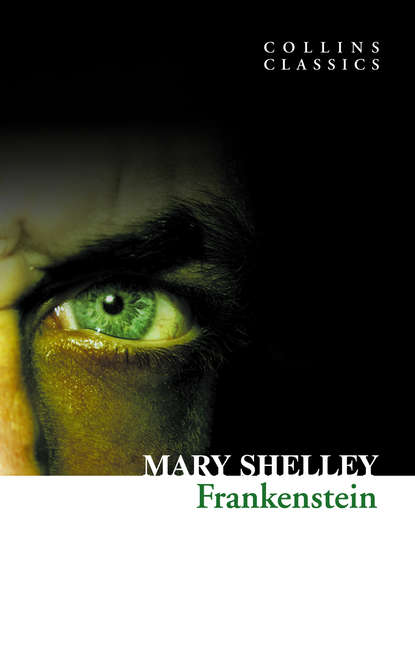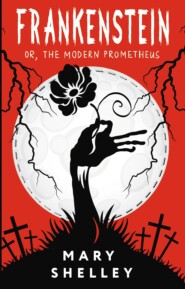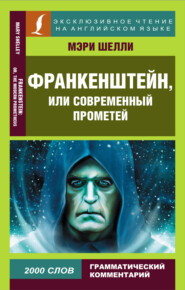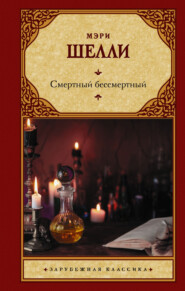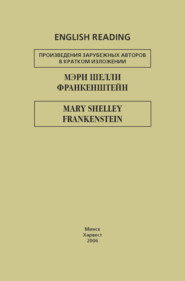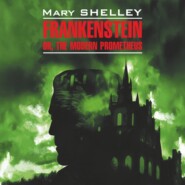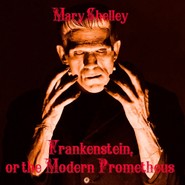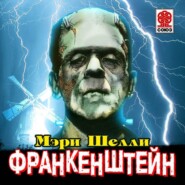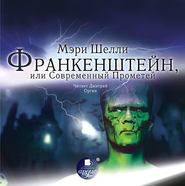По всем вопросам обращайтесь на: info@litportal.ru
(©) 2003-2025.
✖
Frankenstein
Настройки чтения
Размер шрифта
Высота строк
Поля
Frankenstein
Mary Shelley
In the most famous gothic horror story ever told, Shelley confronts the limitations of science, the nature of human cruelty and the pathway to forgiveness.‘The rain pattered dismally against the panes, and my candle was nearly burnt out, when, by the glimmer of the half-extinguished light, I saw the dull yellow eye of the creature open…’Victor Frankenstein’s monster is stitched together from the limbs of the dead, taken from ‘the dissecting room and the slaughter-house’. The result is a grotesque being who, rejected by his maker and starved of human companionship, sets out on a journey to seek his revenge. In the most famous gothic horror story ever told, Shelley confronts the limitations of science, the nature of human cruelty and the pathway to forgiveness.Begun when Mary Shelley was only eighteen years old and published two years later, this chilling tale of a young scientist’s desire to create life – and the consequences of that creation – still resonate today.
Collins Classics
History of Collins (#ulink_3588d663-14c3-53b9-b1f8-8c8db022e795)
In 1819, Millworker William Collins from Glasgow, Scotland, set up a company for printing and publishing pamphlets, sermons, hymn books and prayer books. That company was Collins and was to mark the birth of HarperCollins Publishers as we know it today. The long tradition of Collins dictionary publishing can be traced back to the first dictionary William published in 1824, Greek and English Lexicon. Indeed, from 1840 onwards, he began to produce illustrated dictionaries and even obtained a licence to print and publish the Bible.
Soon after, William published the first Collins novel, Ready Reckoner, however it was the time of the Long Depression, where harvests were poor, prices were high, potato crops had failed and violence was erupting in Europe. As a result, many factories across the country were forced to close down and William chose to retire in 1846, partly due to the hardships he was facing.
Aged 30, William’s son, William II took over the business. A keen humanitarian with a warm heart and a generous spirit, William II was truly ‘Victorian’ in his outlook. He introduced new, up-to-date steam presses and published affordable editions of Shakespeare’s works and Pilgrim’s Progress, making them available to the masses for the first time. A new demand for educational books meant that success came with the publication of travel books, scientific books, encyclopaedias and dictionaries. This demand to be educated led to the later publication of atlases and Collins also held the monopoly on scripture writing at the time.
In the 1860s Collins began to expand and diversify and the idea of ‘books for the millions’ was developed. Affordable editions of classical literature were published and in 1903 Collins introduced 10 titles in their Collins Handy Illustrated Pocket Novels. These proved so popular that a few years later this had increased to an output of 50 volumes, selling nearly half a million in their year of publication. In the same year, The Everyman’s Library was also instituted, with the idea of publishing an affordable library of the most important classical works, biographies, religious and philosophical treatments, plays, poems, travel and adventure. This series eclipsed all competition at the time and the introduction of paperback books in the 1950s helped to open that market and marked a high point in the industry.
HarperCollins is and has always been a champion of the classics and the current Collins Classics series follows in this tradition – publishing classical literature that is affordable and available to all. Beautifully packaged, highly collectible and intended to be reread and enjoyed at every opportunity.
Life & Times (#ulink_007e54bf-b377-5f87-843b-7a0a8873aef4)
About the Author
In 1817 Mary Shelley published a travelogue, detailing a six-week tour of Europe with her husband Percy. Whilst on that tour they visited Castle Frankenstein, on the Rhine, and heard disturbing tales of an occupant who had lived at the castle 100 years before and experimented with human corpses, trying to bring them back to life with alchemy. English society was also familiar with experiments carried out by Italian scientist Giovanni Aldini in the first years of the 1800s, attempting to restore life to corpses with electricity. They resulted in horrifying animations as the muscles contracted over the bones. A year after her tour, Shelley published Frankenstein, her Gothic masterpiece. Shelley wrote a number of subsequent novels, but her husband’s fame as a poet rather overshadowed her achievements, so that her other works became forgotten. Nevertheless, she was a professional writer for the remainder of her life and her achievements have been reassessed in recent years. Frankenstein was such a powerful and thought provoking story that it set the benchmark for horror and it also encapsulated the mindset of the wealthy classes at that time – a class to which the Shelley’s belonged. They were comfortable enough to spend their time reading and writing, as opposed to doing ‘real work’, and they had the spare time to wonder and ponder the meaning of life.
Frankenstein
The novel owes a great deal to the scientific progress and discoveries about electricity at the time. In the late 18th century an Italian scientist, named Luigi Galvani, had shown that frogs legs could be ‘brought back to life’ by stimulating the muscles with electrical sparks. A fellow Italian scientist, named Alessandro Volta, subsequently built the first electric cell, so that further experimentation could be carried out.
By the turn of the 19th century, it was common knowledge among the educated classes that scientists were trying to fathom the essence of life – what it was that kept an organism alive. Perhaps unsurprisingly, those with more extravagant imaginations began to wonder about the consequences of such scientific investigations. Might it be possible to bring people back to life with a jolt of electricity? Might it be possible to assemble a person from component parts and bring them to life? At the time it seemed that anything might be possible because things weren’t understood well enough to know where to draw the line.
This was the environment and starting point for Mary Shelley’s fictional creation Frankenstein’s monster, whose life is described in her 1818 Gothic novel Frankenstein. Victor Frankenstein himself is a scientist in the mould of Galvani and Volta. Through his abundant enthusiasm for science he creates a monster by using electricity to bring a cadaver back to life. The monster is evidently larger and stronger than a normal person. Although Frankenstein does not divulge the details, the implication is that he fabricated the monster by hand and made it oversized so that he could physically tailor it together. When he brings it to life he is immediately horrified by what he has created, but the deed is done so he flees the scene.
The story begins and ends in the Arctic as the majority of the novel is told aboard a ship by way of explanation for Frankenstein’s predicament. In essence the tale is a warning that meddling with nature is not a part of the natural order of things and that it will end in tragedy. Frankenstein is ultimately destroyed by his own creation and the monster then destroys itself because it has the sensibilities of a human and does not want humanity to know of its existence.
The genre of Gothic fiction to which Frankenstein belongs is a curious blend of romance and horror, which began in the late half of the 18th century. The Gothic writers played with the readers’ imaginations by introducing grotesque and disturbing elements to their stories. They were often set in Medieval castles, hence the term ‘Gothic’ and incorporated dungeons, torture devices, the supernatural and so on.
In the case of Mary Shelley, she wrote Frankenstein following a vivid and terrifying dream in which an embryonic idea filled out into a lifelike story. There is a Castle Frankenstein in Germany, where Johan Conrad Dippel practiced alchemy and experimented with bodies prior to the discoveries of Galvani and Volta. It is evident that Shelley visited, or had at least heard tale of the castle whilst on a European tour with her husband and the seed for her novel was planted. However, Shelley was mindful of her place as a female writer and never admitted the influence of the castle, despite it being glaringly obvious, for the sake of maintaining a reputation for originality.
The foundation for Frankenstein was a frightening marriage of baleful tales of experiments with corpses in a Gothic castle and fascinating advances in the science of electricity. Frankenstein fashions a creation from body parts, he uses electricity to bring it to life, the creature is both human and monster, it sets out to destroy its creator.
Shelley described Frankenstein, the man, as the ‘modern Prometheus’ because the eponymous Greek god is the creator of mankind, and he is associated with light and fire, alluding to the electricity. She clearly wanted to express the idea that playing God results in Frankenstein’s own demise.
At the time that Shelley wrote her novel, people were very interested in the occult and other belief systems that countered Christianity. They saw that science was beginning to reveal how and why the world worked, so the logical conclusion was that science might open doors that should remain closed for fear of the consequences.
There is an age-old recognition that science can be put to good or evil use, depending on the motives of scientists. Frankenstein, through his own burning curiosity, cannot resist the temptation of seeing whether he can find the secret to life. His intentions are good in his own mind, but the results are manifestly evil and Shelley’s tale is a cautionary one.
In a pre-Darwinian world, people tied science and religion together, rather than seeing science as a way of constructing the world in the absence of religion. The consequence was that using science to delve too deep could only have the effect of unleashing elements from the dark side. That is Frankenstein’s big mistake, he unleashes the forces of evil on his family and ultimately on himself.
In this way, Shelley’s story reaches a climax with both Frankenstein and his creation dying. Frankenstein can no longer interfere with the natural order of things with his crazy scientific experiments and the personification of evil removes itself from causing more terror by allowing the good side of its own personality to prevail.
Of course, the underpinning theme of good versus evil has always been a successful and popular formula for story telling. It satisfies a tendency in the human mind to compartmentalize things, elements, components, phenomena in life into two boxes. We enjoy the experience of being mentally assaulted by evil events, but we derive the most pleasure from seeing good restored in the end.
The influence of Frankenstein continues to filter down the two centuries since it was written, not least because it is a perfect example of its genre. Even though we now know that corpses cannot be sewn together and sparked to life, it doesn’t stop our imaginations from suspending their disbelief and becoming fully immersed into this dark tale.
Visit www.AuthorTracker.com for exclusive information on your favorite HarperCollins author.
Table of Contents
Cover Page (#ub1f1c7d4-a5fd-5d95-9208-d7fd0d983dbf)
Title Page (#u45767c45-73d0-5fbd-a50e-373a4c47a36b)
History of Collins (#ueeb873c3-7164-5df1-9261-03fb166987ca)
Life & Times (#u3da61be0-c370-5d9b-b613-1eec90f6e0d0)
VOLUME ONE (#u3203bf98-938b-5a3a-82d5-9d6669419b66)
LETTER 1 (#u52206284-7d30-5fb1-b0e1-f7cc20ff5792)
LETTER 2 (#u1c466b52-ef38-5624-8967-747809d16886)
LETTER 3 (#u163cdf09-068c-5d0d-b00c-729e0a900a17)
LETTER 4 (#ua19f0a00-246e-5838-b8c3-8bfa2206afc0)
CHAPTER 1 (#u5e36e6dd-35ca-555e-b583-c7414a650c2f)
CHAPTER 2 (#u7fa3ea2c-81ef-5d60-b7b6-1aa524e5a78f)
CHAPTER 3 (#uabc4c68d-2fc7-5464-a9b6-ad6805ce90b6)
CHAPTER 4 (#u669dcc95-bb05-5849-b76f-6e82942ece8a)
CHAPTER 5 (#u6ad89c06-e887-53fd-9e1a-fdd08c8161aa)
CHAPTER 6 (#ufabe4c35-bca0-5420-815e-40650e7b7400)
CHAPTER 7 (#u85f42a60-e9fa-5972-8a16-ea9592ce3020)
CHAPTER 8 (#litres_trial_promo)
VOLUME TWO (#litres_trial_promo)
CHAPTER 1 (#litres_trial_promo)
CHAPTER 2 (#litres_trial_promo)
CHAPTER 3 (#litres_trial_promo)
Mary Shelley
In the most famous gothic horror story ever told, Shelley confronts the limitations of science, the nature of human cruelty and the pathway to forgiveness.‘The rain pattered dismally against the panes, and my candle was nearly burnt out, when, by the glimmer of the half-extinguished light, I saw the dull yellow eye of the creature open…’Victor Frankenstein’s monster is stitched together from the limbs of the dead, taken from ‘the dissecting room and the slaughter-house’. The result is a grotesque being who, rejected by his maker and starved of human companionship, sets out on a journey to seek his revenge. In the most famous gothic horror story ever told, Shelley confronts the limitations of science, the nature of human cruelty and the pathway to forgiveness.Begun when Mary Shelley was only eighteen years old and published two years later, this chilling tale of a young scientist’s desire to create life – and the consequences of that creation – still resonate today.
Collins Classics
History of Collins (#ulink_3588d663-14c3-53b9-b1f8-8c8db022e795)
In 1819, Millworker William Collins from Glasgow, Scotland, set up a company for printing and publishing pamphlets, sermons, hymn books and prayer books. That company was Collins and was to mark the birth of HarperCollins Publishers as we know it today. The long tradition of Collins dictionary publishing can be traced back to the first dictionary William published in 1824, Greek and English Lexicon. Indeed, from 1840 onwards, he began to produce illustrated dictionaries and even obtained a licence to print and publish the Bible.
Soon after, William published the first Collins novel, Ready Reckoner, however it was the time of the Long Depression, where harvests were poor, prices were high, potato crops had failed and violence was erupting in Europe. As a result, many factories across the country were forced to close down and William chose to retire in 1846, partly due to the hardships he was facing.
Aged 30, William’s son, William II took over the business. A keen humanitarian with a warm heart and a generous spirit, William II was truly ‘Victorian’ in his outlook. He introduced new, up-to-date steam presses and published affordable editions of Shakespeare’s works and Pilgrim’s Progress, making them available to the masses for the first time. A new demand for educational books meant that success came with the publication of travel books, scientific books, encyclopaedias and dictionaries. This demand to be educated led to the later publication of atlases and Collins also held the monopoly on scripture writing at the time.
In the 1860s Collins began to expand and diversify and the idea of ‘books for the millions’ was developed. Affordable editions of classical literature were published and in 1903 Collins introduced 10 titles in their Collins Handy Illustrated Pocket Novels. These proved so popular that a few years later this had increased to an output of 50 volumes, selling nearly half a million in their year of publication. In the same year, The Everyman’s Library was also instituted, with the idea of publishing an affordable library of the most important classical works, biographies, religious and philosophical treatments, plays, poems, travel and adventure. This series eclipsed all competition at the time and the introduction of paperback books in the 1950s helped to open that market and marked a high point in the industry.
HarperCollins is and has always been a champion of the classics and the current Collins Classics series follows in this tradition – publishing classical literature that is affordable and available to all. Beautifully packaged, highly collectible and intended to be reread and enjoyed at every opportunity.
Life & Times (#ulink_007e54bf-b377-5f87-843b-7a0a8873aef4)
About the Author
In 1817 Mary Shelley published a travelogue, detailing a six-week tour of Europe with her husband Percy. Whilst on that tour they visited Castle Frankenstein, on the Rhine, and heard disturbing tales of an occupant who had lived at the castle 100 years before and experimented with human corpses, trying to bring them back to life with alchemy. English society was also familiar with experiments carried out by Italian scientist Giovanni Aldini in the first years of the 1800s, attempting to restore life to corpses with electricity. They resulted in horrifying animations as the muscles contracted over the bones. A year after her tour, Shelley published Frankenstein, her Gothic masterpiece. Shelley wrote a number of subsequent novels, but her husband’s fame as a poet rather overshadowed her achievements, so that her other works became forgotten. Nevertheless, she was a professional writer for the remainder of her life and her achievements have been reassessed in recent years. Frankenstein was such a powerful and thought provoking story that it set the benchmark for horror and it also encapsulated the mindset of the wealthy classes at that time – a class to which the Shelley’s belonged. They were comfortable enough to spend their time reading and writing, as opposed to doing ‘real work’, and they had the spare time to wonder and ponder the meaning of life.
Frankenstein
The novel owes a great deal to the scientific progress and discoveries about electricity at the time. In the late 18th century an Italian scientist, named Luigi Galvani, had shown that frogs legs could be ‘brought back to life’ by stimulating the muscles with electrical sparks. A fellow Italian scientist, named Alessandro Volta, subsequently built the first electric cell, so that further experimentation could be carried out.
By the turn of the 19th century, it was common knowledge among the educated classes that scientists were trying to fathom the essence of life – what it was that kept an organism alive. Perhaps unsurprisingly, those with more extravagant imaginations began to wonder about the consequences of such scientific investigations. Might it be possible to bring people back to life with a jolt of electricity? Might it be possible to assemble a person from component parts and bring them to life? At the time it seemed that anything might be possible because things weren’t understood well enough to know where to draw the line.
This was the environment and starting point for Mary Shelley’s fictional creation Frankenstein’s monster, whose life is described in her 1818 Gothic novel Frankenstein. Victor Frankenstein himself is a scientist in the mould of Galvani and Volta. Through his abundant enthusiasm for science he creates a monster by using electricity to bring a cadaver back to life. The monster is evidently larger and stronger than a normal person. Although Frankenstein does not divulge the details, the implication is that he fabricated the monster by hand and made it oversized so that he could physically tailor it together. When he brings it to life he is immediately horrified by what he has created, but the deed is done so he flees the scene.
The story begins and ends in the Arctic as the majority of the novel is told aboard a ship by way of explanation for Frankenstein’s predicament. In essence the tale is a warning that meddling with nature is not a part of the natural order of things and that it will end in tragedy. Frankenstein is ultimately destroyed by his own creation and the monster then destroys itself because it has the sensibilities of a human and does not want humanity to know of its existence.
The genre of Gothic fiction to which Frankenstein belongs is a curious blend of romance and horror, which began in the late half of the 18th century. The Gothic writers played with the readers’ imaginations by introducing grotesque and disturbing elements to their stories. They were often set in Medieval castles, hence the term ‘Gothic’ and incorporated dungeons, torture devices, the supernatural and so on.
In the case of Mary Shelley, she wrote Frankenstein following a vivid and terrifying dream in which an embryonic idea filled out into a lifelike story. There is a Castle Frankenstein in Germany, where Johan Conrad Dippel practiced alchemy and experimented with bodies prior to the discoveries of Galvani and Volta. It is evident that Shelley visited, or had at least heard tale of the castle whilst on a European tour with her husband and the seed for her novel was planted. However, Shelley was mindful of her place as a female writer and never admitted the influence of the castle, despite it being glaringly obvious, for the sake of maintaining a reputation for originality.
The foundation for Frankenstein was a frightening marriage of baleful tales of experiments with corpses in a Gothic castle and fascinating advances in the science of electricity. Frankenstein fashions a creation from body parts, he uses electricity to bring it to life, the creature is both human and monster, it sets out to destroy its creator.
Shelley described Frankenstein, the man, as the ‘modern Prometheus’ because the eponymous Greek god is the creator of mankind, and he is associated with light and fire, alluding to the electricity. She clearly wanted to express the idea that playing God results in Frankenstein’s own demise.
At the time that Shelley wrote her novel, people were very interested in the occult and other belief systems that countered Christianity. They saw that science was beginning to reveal how and why the world worked, so the logical conclusion was that science might open doors that should remain closed for fear of the consequences.
There is an age-old recognition that science can be put to good or evil use, depending on the motives of scientists. Frankenstein, through his own burning curiosity, cannot resist the temptation of seeing whether he can find the secret to life. His intentions are good in his own mind, but the results are manifestly evil and Shelley’s tale is a cautionary one.
In a pre-Darwinian world, people tied science and religion together, rather than seeing science as a way of constructing the world in the absence of religion. The consequence was that using science to delve too deep could only have the effect of unleashing elements from the dark side. That is Frankenstein’s big mistake, he unleashes the forces of evil on his family and ultimately on himself.
In this way, Shelley’s story reaches a climax with both Frankenstein and his creation dying. Frankenstein can no longer interfere with the natural order of things with his crazy scientific experiments and the personification of evil removes itself from causing more terror by allowing the good side of its own personality to prevail.
Of course, the underpinning theme of good versus evil has always been a successful and popular formula for story telling. It satisfies a tendency in the human mind to compartmentalize things, elements, components, phenomena in life into two boxes. We enjoy the experience of being mentally assaulted by evil events, but we derive the most pleasure from seeing good restored in the end.
The influence of Frankenstein continues to filter down the two centuries since it was written, not least because it is a perfect example of its genre. Even though we now know that corpses cannot be sewn together and sparked to life, it doesn’t stop our imaginations from suspending their disbelief and becoming fully immersed into this dark tale.
Visit www.AuthorTracker.com for exclusive information on your favorite HarperCollins author.
Table of Contents
Cover Page (#ub1f1c7d4-a5fd-5d95-9208-d7fd0d983dbf)
Title Page (#u45767c45-73d0-5fbd-a50e-373a4c47a36b)
History of Collins (#ueeb873c3-7164-5df1-9261-03fb166987ca)
Life & Times (#u3da61be0-c370-5d9b-b613-1eec90f6e0d0)
VOLUME ONE (#u3203bf98-938b-5a3a-82d5-9d6669419b66)
LETTER 1 (#u52206284-7d30-5fb1-b0e1-f7cc20ff5792)
LETTER 2 (#u1c466b52-ef38-5624-8967-747809d16886)
LETTER 3 (#u163cdf09-068c-5d0d-b00c-729e0a900a17)
LETTER 4 (#ua19f0a00-246e-5838-b8c3-8bfa2206afc0)
CHAPTER 1 (#u5e36e6dd-35ca-555e-b583-c7414a650c2f)
CHAPTER 2 (#u7fa3ea2c-81ef-5d60-b7b6-1aa524e5a78f)
CHAPTER 3 (#uabc4c68d-2fc7-5464-a9b6-ad6805ce90b6)
CHAPTER 4 (#u669dcc95-bb05-5849-b76f-6e82942ece8a)
CHAPTER 5 (#u6ad89c06-e887-53fd-9e1a-fdd08c8161aa)
CHAPTER 6 (#ufabe4c35-bca0-5420-815e-40650e7b7400)
CHAPTER 7 (#u85f42a60-e9fa-5972-8a16-ea9592ce3020)
CHAPTER 8 (#litres_trial_promo)
VOLUME TWO (#litres_trial_promo)
CHAPTER 1 (#litres_trial_promo)
CHAPTER 2 (#litres_trial_promo)
CHAPTER 3 (#litres_trial_promo)





